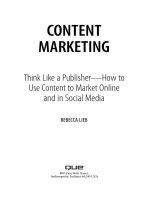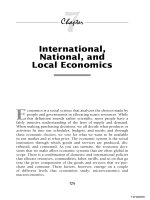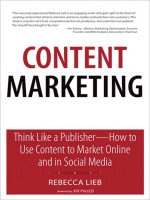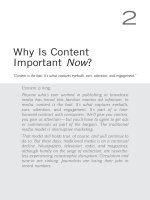Content marketing think like a publisher chapter 7 providing utility
Bạn đang xem bản rút gọn của tài liệu. Xem và tải ngay bản đầy đủ của tài liệu tại đây (931.6 KB, 8 trang )
7
Providing Utility
When most people think content, they think written, visual,
or audio-visual media: words, pictures, photos, video,
audio, and perhaps graphs, charts, and infographics. It can
be persuasively argued that in a digital environment, tools
count as content, too. They can be educational, informative, helpful, decision and buying aids, entertaining, interactive…and above all, useful.
Think of them as utility content. And think how many
times you’ve used them.
Think financial services sites offering loan calculators, or
retirement calculators and applications that do comparative
math for different types of mortgages or help calculate a savings goal. Consider how many times you’ve visited eBay,
UPS, USPS.com, or Amazon.com to figure out shipping
rates, shipping speed, package tracking, or parcel arrival.
Financial tools extend to automotive dealer sites as well, but
so do utilities that help you select and configure a vehicle
(see Figure 7.1). Two doors or four? How does red look versus green? How much extra for the souped-up audio system
or heated seats? These utilities don’t just help prospective
buyers make decisions; they also put them into the position
of weighing all their options. And it’s not only manufacturers who use utilities. Sites such as AutoTraders also have
this type of tool, so a buyer can pinpoint the vehicle for sale
in her area that comes closest to her dream machine.
40
Part II
W h a t K i n d o f C o n t e n t A r e Yo u ?
Figure 7.1 What are the features of your perfect car, and how far would you be willing to travel to get it? AutoTrader has a tool to help you figure out just that.
These types of utility content not only aid in decision-making, but also help to
bring prospects closer to purchase.
Such tools go beyond packages and cars, even getting very personal indeed.
Retailers have built tools to help find jeans that will flatter your body type and show
you an image of what you’d look like in them, not some six-foot tall, 98-pound
model. Not dissimilarly, any number of sites allows you to upload a headshot to try
a virtual makeover on for size (see Figure 7.2). Testing how different hairstyles and
colors or makeup looks online is another step toward conversion, just as it is at the
department store counter. It’s also a step toward the potential customer, offering
them tools and information to help them in buying and decision making.
Utility content can range from the super-simple to the mega-slick. At the low end,
it can be as simple as publishing glossaries or dictionaries of highly technical or
industry-related terms to help newcomers navigate a new field of knowledge.
Utility can also be a matter of packaging content so that it’s easy to consume or use
on the go. Obvious examples are publisher sites such as The New York Times or The
Wall Street Journal that are good to go as apps on a smartphone or tablet computer.
That same utility shows up when conference or seminar organizers publish agendas
in mobile formats that contain functionality such as schedules (official and personalized), directories of who’s attending, and perhaps even the event newsletter or a
map of the trade show or convention center. Some would argue these are tools, not
content. But is there really a reason why content can’t be both?
Chapter 7
Providing Utility
41
Figure 7.2 Would you really look better as a blonde? Try it on for size before reaching
for the peroxide.
Many content utilities are, in essence, searchable databases. They’re rife in the food
industry. No celebrity chef worth his salt is without one. Martha Stewart, Jamie
Oliver, and a host of others have searchable recipe databases with additional functionality, such as nutrition information and the ability to churn out a shopping list
(see Figure 7.3). Kraft Foods has its own recipe database, complete with apps and
additional tools, such as ones that help shoppers find in-season produce. In the same
vein, so does Weber’s, only its offering is geared toward customers who are interesting in grilling, marinating, and finding
food and recipes in line with the company’s
line of grills and outdoor cooking products.
Fast food outlets from Dairy Queen to
Taco Bell to Panera Bread have nutrition
calculators for their menu offerings. So do
sites for diabetics, and other health- and
disease-oriented businesses. Dominos and
Pizza Hut offer apps and tools that help
you sift through their menus and then
order food online or via your phone. Some
of these have tracking functionality so that
buyers know when their order has been
received, is in the oven, and is out for
delivery.
“Even some of the
most unlikely products you can think
of have come up
with ways to provide users with utilitarian content
while keeping the
brand top-of-mind.”
42
Part II
W h a t K i n d o f C o n t e n t A r e Yo u ?
Even some of the most unlikely products you can think of have come up with ways
to provide users with utilitarian content while keeping the brand top-of-mind.
SitOrSquat, an app sponsored by Charmin toilet tissue, is a geo-location-sensitive
database of the best places in the world to find clean restroom facilities (see
Figure 7.4). Users have the ability to update the information.
Figure 7.3 What to cook? What ingredients do you need to cook it? How the heck do
you cook it? Jamie Oliver’s app shows, and tells.
Figure 7.4 When you gotta go, SitorSquat helps you decide where to go by locating
the nearest, cleanest toilet.
Most major banks offer similar tools that help you find the nearest branch or ATM
machine (see Figure 7.5). Chase even allows you to make a deposit online or by smartphone by taking a digital photo of the check and then uploading it to your account.
Chapter 7
Figure 7.5
Providing Utility
43
Check your balance, even deposit a check—all with your mobile phone.
There are other ways to help users buy on a geographic basis. Burpee, the venerable
seed catalogue, has information on the proper plants and flowers for different
growing zones (see Figure 7.6). By entering your zip code on the site, not only is
shipping information more accurate, but products are featured that are tailored to
your area, as are suggestions for planning and planting a garden. Plan-a-Garden
from Better Homes and Gardens has similar functionality: delivering more relevant
content to its readers.
Figure 7.6 How doth your garden grow? Depends on where you live. Burpee’s got a
tool for that.
44
Part II
W h a t K i n d o f C o n t e n t A r e Yo u ?
“Interactive online
tools are almost de
rigeur in digital
publishing—and
remember, brands
are now publishers.”
Interactive online tools are almost de
rigueur in digital publishing—and remember, brands are now publishers. When I
led one of the largest sites covering digital
advertising, we published literally hundreds of articles every week. But week in,
week out, one of the most-visited pages on
the site was the years-old CPM calculator
that helped online advertisers calculate
how much they were paying for their
online advertising. The Laredo Group, a
company that offers training in online
advertising, offers the ROAS calculator, which is a tool that tracks return on advertising spend. Similarly, sites such as DPReview.com allow shoppers to make side-byside comparisons of different models of digital cameras by price and feature.
Technology companies are, unsurprisingly, big on tools, either to help prospective
customers better understand their businesses or to let them sample the more robust
commercial versions of their offerings. Both Alexa and Compete offer website
ranking and competitive analysis. You can learn a lot, both about how your own
site is performing and the power of analytics, by diving into the free versions of
their software online.
Search engine marketers often turn to free keyword research tools offered not only
by the major search engines, but also by companies such as Wordtracker. Not dissimilar are utilities that analyze on-page keyword density, or tools for email marketers that calculate the likelihood of a message being flagged as spam based on
trigger words in the subject line and message body.
Another industry in which content utility is rife is health care. Users can remain
engaged and educated when offered the opportunity to calculate their own body
mass index, risk of contracting certain types of cancer, or tracking their level and
optimum times for fertility.
Big brands bring big splashiness to utility content. Take Nike. Not only does the
company offer a sophisticated Shoe Finder to help runners find the right shoe for
their style of running, but Nike iD also allows them to custom-design shoes, selecting their own colors and custom sole (see Figure 7.7). Nike has taken utility to the
extreme with Nike+, which combines a running shoe and an Apple device that
tracks joggers’ runs and then logs them online. In this case, customers buy the product not only because of the gold-standard brands (Nike and Apple), but also because
the functionality allows them, in effect, to create their own content. They can track
miles run, calories burned, and other fitness benchmarks and compare them to
friends’ progress, map routes, and a host of other running-related information.
Chapter 7
Providing Utility
45
Figure 7.7 Scratch that. I’d rather have the pink laces and the turquoise sole on my
orange running shoes.
These examples just scratch the surface of what must be hundreds of thousands of
content-related utilities out there that bring people that much closer, for that much
longer, with brands, products, and services. Utility content isn’t the first resort of
most content marketers. Generally, you’ll need the help of developers or programmers to get an initiative off the ground. It’s a somewhat more daunting prospect
than writing an article or blog post or investing a small amount of money in a digital camera.
The barrier to entry is higher. But it’s not much
higher, and it’s becoming easier every day.
Moreover, as the digital environment increasingly
shifts to mobile platforms such as smartphone and
computers, it will become increasingly important
to offer a degree of functionality (where’s the nearest john?), not only information or entertainment.
What do your customers need to do, find, know,
learn, or understand to get closer to your being
able to fulfill their need? It’s your job to figure that
out and provide the utility to get them there.
“What do your
customers need
to do, find,
know, learn, or
understand….
It’s your job to
figure that out.”
This page intentionally left blank









